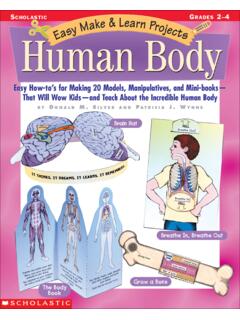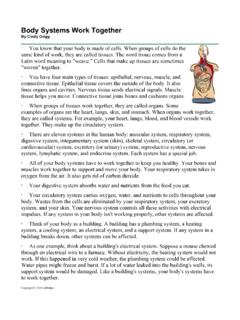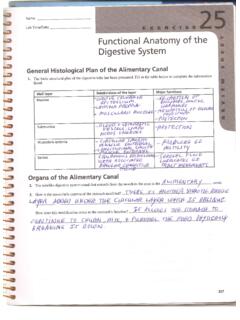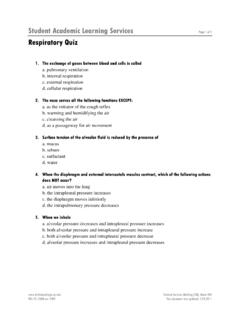Transcription of Lecture 2: Insect Morphology
1 Introduction to Applied Entomology, University of Illinois Insect Morphology Morphology : THE STUDY OF FORM AND FUNCTION Insects are arthropods: Arthropoda: "jointed feet" Insecta: from insectum; to cut into General characteristics of arthropods: Segmented bodies Paired, segmented appendages Bilateral Symmetry Exoskeleton Dorsal heart and open circulatory system Ventral nerve cord General characteristics of insects: The body is comprised of 3 distinct body regions -- head, thorax, and abdomen The thorax of adults bears 3 pairs of legs and 2 pairs of wings The "breathing" system is comprised of air tubes A look at the outside of an Insect : The exoskeleton is comprised of sclerites: hardened plates Tergites: Dorsal plates Sternites: Ventral plates Pleuron: Lateral area, often membranous The integument (body covering) is comprised of multiple layers.
2 The cuticle is the outermost layer, covering the entire outer body surface; it also lines the air tubes (tracheae, etc.), salivary glands, foregut, and hindgut Strength and resilience (not hardness) are provided by chitin, a nitrogen-containing polymer common to the arthropods The Insect head bears: mouthparts, eyes, and antennae. Introduction to Applied Entomology, University of Illinois Mouthparts: Labrum (1) (Upper lip) Mandibles (2) (Jaws) Maxillae (2) (More jaws) Labium (1) (Lower lip) Hypopharynx (1) (Tongue-like, bears openings of salivary ducts) Labrum-epipharynx (1) (Fleshy inner surface of labrum - sensory) Mouthparts may be modified greatly from the "generalized" plan .. see illustrations of the cicada and the house fly in comparison with the general form exhibited by the grasshopper.
3 Introduction to Applied Entomology, University of Illinois The orientation of the mouthparts on the head may differ, and they may be described as: Prognathous: projecting forward (horizontal) Hypognathous: projecting downward Opisthognathous: projecting obliquely or posteriorly Eyes: Compound eyes: Individual units are facets or ommatidia. 28,000 ommatidia comprise a single compound eye in dragonflies Oellus (Ocelli), or simple eyes: small, usually a single lens Antennae: 2 basal segments are the scape & pedicel The filament is comprised of several segments (actually pseudo-segments lacking independent musculature) a. setaceous: hair-like b. and f. filiform: thread-like c. moniliform: bead-like d.
4 Serrate: sawtoothed e. pectinate: comb-like g. capitate: headlike (less enlarged at the tip would be clavate -- clublike) h. geniculate: elbowed i. lamellate: plate-like j. plumose: plumed or feather-like Introduction to Applied Entomology, University of Illinois The Insect thorax: 3 distinct segments: Prothorax: Bears 1 pair of legs Mesothorax: Bears 1 pair of legs, 1 pair of wings Metathorax: Bears 1 pair of legs, 1 pair of wings Sclerites that comprise the thorax are given specific names; each may be preceded by the prefixes pro-, meso-, or meta-. Notum: Dorsal plate or sclerite. The pronotum is the dorsal sclerite on the prothorax. Pleuron: Lateral plate Sternum: Ventral plate Legs are segmented.
5 The names for each segment are (in order, beginning at the body and progressing outward. coxa trochanter femur tibia tarsus Introduction to Applied Entomology, University of Illinois The tarsus may be comprised of multiple segments (not really true segments; more accurately called tarsomeres); the terminal segment usually bears claws. Legs may be modified for specific purposes: Jumping: saltatorial -- grasshoppers, fleas Running (or walking): cursorial -- ground beetles, cockroaches Clinging: scansorial -- lice, sheep keds Grasping (holding prey): raptorial -- mantids, giant water bugs Digging: fossorial -- cicada nymphs, mole crickets Swimming: natatorial -- water scavenger beetle, backswimmer Wings Mesothoracic wing = forewing Metathoracic wing = hindwing Wing veins and cells between veins are named according to the standard system illustrated below: Introduction to Applied Entomology, University of Illinois Wing modifications: Halteres (Halter): Knob-like reduced hind wings of Diptera Elytra (Elytron).)
6 Hardened, protective forewings of Coleoptera Hemelytra: Half-hardened, half-membranous forewings of Hemiptera (Heteroptera) Fringed wings: Modified wing structure of the Thysanoptera (Thrips) Scales and hairs: Lepidoptera, Trichoptera, some Diptera The Insect abdomen .. is comprised of 6 to 10 segments. Terminal structures include: Cerci: Paired sensory projections from the terminal abdominal segment Ovipositor: Egg-laying apparatus (may be modified for other purposes) Aedeagus: Male copulatory organ, analogous to the penis in vertebrates (Homologous = structures with similar evolutionary origin but different function, such as the different forms of mandibles in insects. Analogous = structures with similar functions but different evolutionary origins, such as the wings in birds versus insects.)
7 Inside the Insect : Digestive system : A tube that extends from the mouth to the anus; there are 3 sections: Foregut: Pharynx (throat) Esophagus (gullet) Crop (storage) Proventriculus (may be muscled, gizzard-like) Midgut: Gastric caecae (blind sacs) (food storage and enzymes) Ventriculus (most digestion, absorption here) Hindgut: Anterior intestine (excretory organs empty in) Rectum (reabsorption of water) Anus In embryonic development, the foregut and hindgut are formed from ectoderm .. their surfaces are shed during molting. The midgut is formed from the endoderm; its surface is retained during molting. Introduction to Applied Entomology, University of Illinois Digestion: Some insects use external digestion in addition that which occurs internally.
8 Leafhoppers inject saliva into plant tissues house flies regurgitate salivary enzymes onto the surface of food diving beetles inject prey with salivary juices Most digestive action is in the midgut; gastric caecae are rich in enzymes. Enzyme diversity varies with the range of foods that different insects eat .. more proteolytic enzymes in blood feeders, cellulase in wood-boring beetles, etc. Excretory system : Purpose of excretion: Removal of nitrogenous wastes Maintenance / regulation of salts and water balance Primary excretory organs: Malpighian tubules and the rectum. Malpighian tubules "float" in the hemolymph; active transport moves wastes (uric acid salts from the fat body) into tubules. Malpighian tubules empty into the hind gut; water is reabsorbed.
9 Excretory and fecal wastes are combined. Nervous system : The brain = the supraesophageal ganglion (nerve cell mass above the esophagus) Optic lobes (paired): the largest lobes of the brain; each protrudes from the protocerebrum Protocerebrum (paired): innervates compound eyes and ocelli Deutocerebrum (paired) innervates antennae Tritocerebrum (paired) connect to the visceral nervous system Circumesophageal connectives (paired) -- from the dorsal brain to the ventral nerve cord Introduction to Applied Entomology, University of Illinois The ventral nerve cord: connects segmental ganglia (nerve cell bundles). Thoracic and abdominal ganglia control many body operations. The corpora cardiaca and corpora allata are neuroendocrine glands.
10 Lecture 3 will include more on neurohormones and their function. Chemoreceptors (taste and smell) take the form of sensory pegs on various body structures, particularly antennae, tarsi, and palpi. Photoreceptors are located in the compound eyes and the ocelli (and also the cuticle). Hearing organs may be located on the abdomen (grasshoppers), tibiae (crickets), or thorax (moths). respiratory system (tracheal system ): Spiracles: External openings on each side of most body segments Tracheae: large tubes that run the length of the body on each side. Smaller tubes are called tracheal branches and tracheoles. Air sacs that store air (air, not just oxygen) may be located in the abdomen and/or the thorax. Introduction to Applied Entomology, University of Illinois Special modifications oxygen and CO2 exchange: Stoneflies and mayflies: external gills Dragonflies: Rectal gills; water is drawn in and out over these gills Aquatic beetles (some): Plastron.




